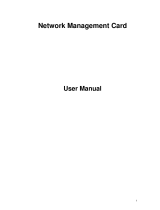
Dell UPS Management Software: Common Software Installation Scenarios
ii
Contents
Scope of this document ............................................................................................. 4
Assumptions ........................................................................................................... 5
The two components of Dell UPS Management Software ...................................................... 5
An overview of UPS shutdown ...................................................................................... 7
Scenario 1: Single UPS, multiple servers, USB or RS232 local communication ............................. 8
Scenario 1: Connectivity ............................................................................................ 8
Scenario 1: Installation notes .................................................................................... 9
Scenario 2: Single UPS, multiple servers, Ethernet connectivity using the NMC .......................... 13
Scenario 2: Connectivity......................................................................................... 13
Scenario 2: Installation notes ................................................................................... 14
Scenario 2: Mass configuration of all ULNM agents and Dell UPSs on a network ....................... 15
Scenario 3: Redundant UPS, multiple servers, Network (Ethernet) Management Card (NMC)
connection ............................................................................................................ 17
Scenario 3: Connectivity......................................................................................... 18
Scenario 3: Installation notes ................................................................................... 18
APPENDIX I .............................................................................................................. 21
Firewall configuration (software communication ports) ...................................................... 21
APPENDIX 2 .............................................................................................................. 22
Shutdown settings ................................................................................................... 22
Shutdown setting listing and description ..................................................................... 22
Figures
Figure 1: Dell UPS management software connectivity scenarios ............................................... 4
Figure 2: Dell’s UPS Local Node Manager (ULNM) .................................................................. 6
Figure 3: Dell’s Multi-UPS Management Console (MUMC) ......................................................... 7
Figure 4: Connectivity for Dell UPS with USB or RS232 connection to four Dell servers ..................... 9
Figure 5: ULNM edit modules settings .............................................................................. 10
Figure 6: ULNM range scan ........................................................................................... 10
Figure 7: ULNM Settings Auto Discovery ......................................................................... 10
Figure 8: ULNM edit power source .................................................................................. 11
Figure 9: Power source information and status ................................................................... 11
Figure 10: Nodes settings Edit shutdown settings ............................................................. 12
Figure 11: Connectivity for Dell UPS with optional UPS NMC and four Dell Servers ......................... 13
Figure 12: ULNM range scan .......................................................................................... 14
Figure 13: ULNM edit power source ................................................................................. 14
Figure 14: ULNM edit shutdown configuration ..................................................................... 15
Figure 15: MUMC range scan .......................................................................................... 15
Figure 16: MUMC auto discovery node list ...................................................................... 16
Figure 17: MUMC node settings ...................................................................................... 16
Figure 18: MUMC node configuration................................................................................ 17




















